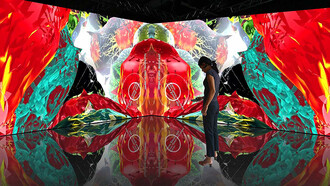Hans-Peter Feldmann is in possession of a lethal sense of humour; I don’t think I’ve experienced an art-induced belly laugh of this magnitude since I ‘flew’ on Carsten Höller’s ‘Decision’ at the London Southbank well over a year ago.
Feldmann’s latest works, as seen at Frieze and currently at Simon Lee in Hong Kong, bring painting ‘to book’ in the context of a conducive gallery environment away from the bustle of art fairs. Here one can ponder the works in the relative tranquility of a typically bijoux HK space. The flat lighting of the gallery is simply fabulous and serves the work well, with the weird and wonderful arrangement of paintings mirroring perfectly the awkwardness in the space and the disrupted subject of the portrayals.
The exhibition presents us with gilt-edged images of clown-nosed couples, boss-eyed beauties and anonymized nudes, eyes cunningly redacted to protect their identities à la Readers Wives 1960’s vintage (I am just surmising of course). In this context, Feldmann manages to manouvre us into a head space where we cannot help but draw the analogy between cosmetics and painting; painting faces and painting canvases if you will. In this way we are snared into viewing the vagaries of make-up, lipstick and the trappings of modernity as being just as ridiculous as the moribund portrayals of the sitters in the appropriated canvases: An insight delivered with the post-mortem savagery we are more accustomed to encountering in Shakespeare’s Hamlet .
Hans-Peter’s beleaguered, disfigured and amended portraits disrupt the innocuous craft-flow of these anonymous and stylistically eponymous bourgeois portraits, but, as with any intervention-as-art, the risks of misjudging the moment, medium and dexterity of interruption in the appropriated plane are great and difficult to pull off. He does this incredibly well. There are a couple of reclining nudes where I found myself searching for the clever smudge or eye lift, until my own eye fell with uncertainty, and some momentary disbelief, onto the tell-tale bikini lines of the faux bagneuse. Yes it’s a hoot.
This work harpoons both painting and po-faced art history in a way that is astute, hugely intelligent and, for me, quite refreshing. Weirdly, after raking through the memory, the closest I could get to describing the iconoclastic/fun feeling of this show took me back to my first encounter with Opie’s ‘Eat Dirt, Art History’, at the Lisson in London back in ’83. The same kind of mobility, daring and deft target-practice. Don’t forget too that it’s also pretty smart of HPF to be able to bring non-labour intensive old/new product to market at a time of considerable fund manager nervousness around contemporary art as an investment vehicle.
And yet… there is something else going on here, if these were photographs, we would simply say that this is ‘Photoshop art’, but these images are much harder to dismiss as simple re-touching. There is something beyond the pastime of spot-the-artists-intervention that pulls one up slightly short; the defacing of these once cherished but (in reality) unimportant artefacts lends some real questions to the value and timelessness [1] of ‘great art’ by association. The subject’s mortality is implied through these ‘lost’ works, works that have lost their meaning, their relevance and certainly their owners/commissioners.
Perhaps ‘vainglorious’ is too harsh a term, but Feldmann skewers not only the subjects, but portraiture itself with bident accuracy as he highlights the accomplished irrelevance of these paintings. His reactivation and appropriation of these images of dogs and children summon a strange and simultaneous power through the re-working, a rare power that invokes both nostalgia and iconoclasm. Whilst we are patently not even in the same ‘Dulux’- rich forest as the superbly bodged ‘restoration’ of Martinez’ Ecco Homo [2] in a church near Zaragoza, the terminal effect of HPF’s work can be hilariously similar and not to be underestimated. After all, the restoration-by-obliteration of the (over-rated), original Martinez masterpiece has become a global icon and virtual antichrist-rival to La Gioconda.
It was I believe, Saint Bernard of Clairvaux who, in the mid-12th Century, roughly coined the epithet ‘the road to hell is paved with good intentions’ - and the poor octogenarian who ‘restored’ Martinez work can attest to that all too well I fear. But let’s get to the point, the intention is the key here, and there is nothing inadvertent or accidental about the opportunism of Feldmann’s observational brilliance, his eye for the main chance in these works, and in previous outputs has always been choice. So let humour be our refuge from seriousness in contemporary art and at least stall us from reflecting too closely on our own mortality by proxy. Feldmann’s work, for all its humour, is undoubtedly possessed of a deep, underlying melancholy that leaves on feeling cheered for only a short while, but still laughing.
Works can be seen at the Simon Lee Gallery Hong Kong until 12 January 2017.
[1] Shakespeare, W. (2006) Hamlet - Arden Shakespeare: Third series (Arden Shakespeare: Third series). Act 5 Scene 1. Edited by Ann Thompson and Neil Taylor. London: Arden Shakespeare. In-line Citation: (Shakespeare, 2006)
[2] I doubt that any self-respecting quantum physicist would subscribe to the notion of ‘timelessness’ by the way
[3] Sanctuary of Mercy Church near Zaragoza















